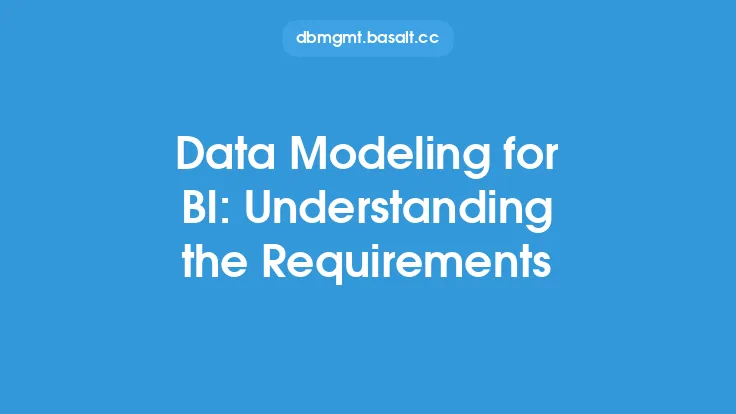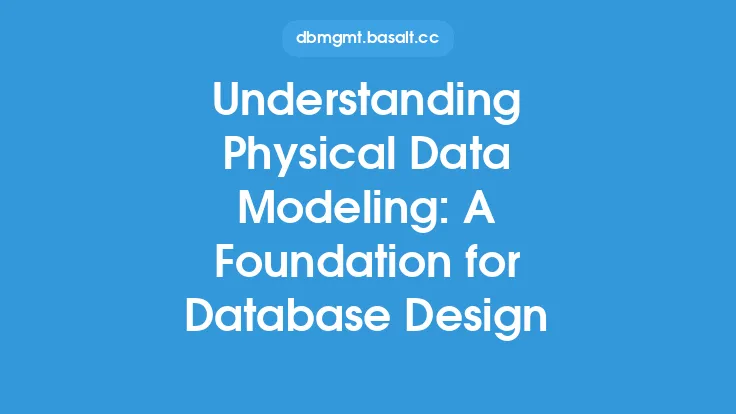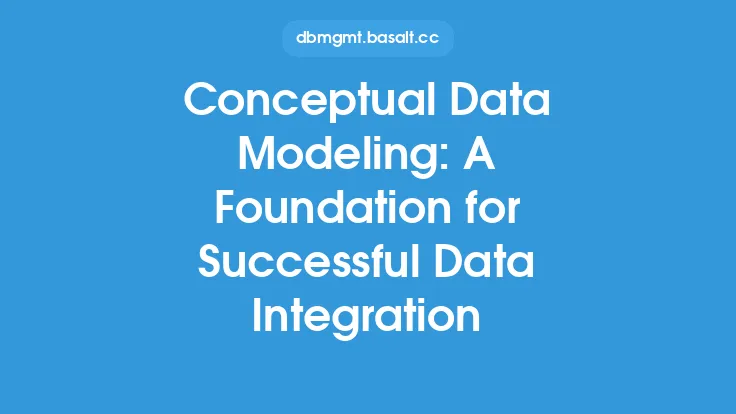Data modeling is a crucial aspect of data management, as it enables organizations to create a conceptual representation of their data assets. One of the key concepts in data modeling is data granularity, which refers to the level of detail or precision at which data is represented. Understanding data granularity is essential for effective data modeling, as it directly impacts the accuracy, relevance, and usability of the data.
Introduction to Data Granularity
Data granularity is a measure of the level of detail or precision at which data is represented. It can range from high-level, aggregated data to low-level, detailed data. High-level data is often used for strategic decision-making, while low-level data is used for operational or tactical decision-making. For example, a company's total sales revenue is a high-level, aggregated data point, while the sales revenue for a specific product in a specific region is a lower-level, more detailed data point.
Types of Data Granularity
There are several types of data granularity, including:
- Temporal granularity: This refers to the level of detail at which time-related data is represented. For example, data can be represented at the year, quarter, month, day, or hour level.
- Spatial granularity: This refers to the level of detail at which geographic data is represented. For example, data can be represented at the country, state, city, or zip code level.
- Categorical granularity: This refers to the level of detail at which categorical data is represented. For example, data can be represented at the category, subcategory, or individual item level.
- Quantitative granularity: This refers to the level of detail at which numerical data is represented. For example, data can be represented at the total, average, or individual transaction level.
Factors Affecting Data Granularity
Several factors can affect the level of data granularity required, including:
- Business requirements: The level of data granularity required will depend on the business requirements and the decisions that need to be made. For example, a company may require detailed sales data to optimize pricing and inventory levels.
- Data quality: The level of data granularity will also depend on the quality of the data. For example, if the data is incomplete or inaccurate, it may not be possible to represent it at a detailed level.
- Data volume: The volume of data will also impact the level of granularity required. For example, if the data volume is very large, it may be necessary to aggregate the data to make it more manageable.
- Data complexity: The complexity of the data will also impact the level of granularity required. For example, if the data is complex and has many relationships, it may be necessary to represent it at a more detailed level.
Benefits of Appropriate Data Granularity
Appropriate data granularity can have several benefits, including:
- Improved decision-making: By representing data at the correct level of granularity, organizations can make more informed decisions.
- Increased efficiency: By aggregating data to the correct level, organizations can reduce the amount of data that needs to be processed and analyzed.
- Better data governance: By representing data at the correct level of granularity, organizations can improve data governance and reduce the risk of data errors or inconsistencies.
- Enhanced data analysis: By representing data at the correct level of granularity, organizations can perform more detailed and accurate data analysis.
Challenges of Inappropriate Data Granularity
Inappropriate data granularity can have several challenges, including:
- Inaccurate decision-making: If data is represented at too high or too low a level of granularity, it can lead to inaccurate decision-making.
- Inefficient data processing: If data is represented at too detailed a level, it can lead to inefficient data processing and analysis.
- Poor data governance: If data is represented at too high or too low a level of granularity, it can lead to poor data governance and increased risk of data errors or inconsistencies.
- Limited data analysis: If data is represented at too high or too low a level of granularity, it can limit the ability to perform detailed and accurate data analysis.
Best Practices for Data Granularity
To ensure appropriate data granularity, organizations should follow several best practices, including:
- Define business requirements: Clearly define the business requirements and the decisions that need to be made.
- Assess data quality: Assess the quality of the data and determine the level of granularity that is possible.
- Consider data volume and complexity: Consider the volume and complexity of the data and determine the level of granularity that is necessary.
- Use data modeling techniques: Use data modeling techniques, such as entity-relationship modeling, to represent data at the correct level of granularity.
- Monitor and adjust: Monitor the level of data granularity and adjust as necessary to ensure that it continues to meet business requirements.
Tools and Techniques for Data Granularity
Several tools and techniques can be used to manage data granularity, including:
- Data modeling software: Data modeling software, such as entity-relationship modeling tools, can be used to represent data at the correct level of granularity.
- Data warehousing: Data warehousing can be used to aggregate data to the correct level of granularity.
- Business intelligence tools: Business intelligence tools, such as reporting and analytics software, can be used to analyze data at the correct level of granularity.
- Data governance frameworks: Data governance frameworks can be used to ensure that data is represented at the correct level of granularity and that data quality is maintained.
Conclusion
Data granularity is a critical aspect of data modeling, as it directly impacts the accuracy, relevance, and usability of the data. By understanding the types of data granularity, factors that affect data granularity, and benefits of appropriate data granularity, organizations can create effective data models that meet their business requirements. By following best practices and using tools and techniques, such as data modeling software and data warehousing, organizations can ensure that their data is represented at the correct level of granularity and that they can make informed decisions.





